South American Sandwiches (of Northeastern Minnesota)
Excerpt from a conversation with Mindy
MINDY: What kind of sandwich is this again?
JIM: South American
MINDY (looking at me quizzically): Which country?
JIM: They’re from Minnesota.
MINDY:
MINDY:
MINDY: What?
The Iron Range
During the early 20th Century, immigrants began pouring into a previously little-populated area of Northeastern Minnesota. In the late 19th Century, iron ore deposits–good ones, near the surface, easy to work–were located in three different ranges within the “arrowhead” formed by the northern shore of Lake Superior and the Canadian border, and the need for laborers to work the mines that began springing up coincided with a fresh wave of immigration, largely from northern and eastern Europe. For a while, northeastern Minnesota had one of the more diverse populations in the country.
Forty-three different nationality groups populated the Iron Range. The earliest immigrants were Finnish, Swedish, Slovenian, Canadian, Norwegian, Cornish, or German. After 1900, the origins of the population expanded, with Italian, Croatian, Polish, Montenegrin, Serbian, Bulgarian, Romanian, Slovak, Hungarian, and Greek immigrants filling mining jobs. A sizeable Jewish population started main street businesses. Chinese immigrant men ran restaurants and laundries.
“How Immigrants Shaped the Iron Range,” David LaVigne, minnpost.com
A generation or two into the life of the Iron Range, this distinctively divergent mix of nationalities had resulted in a culinary melting pot as well. Cultural lines blend and shift, and beloved dishes may be pulled from Scandinavian, Ashkenazi, Austro-Hungarian or Anglo-American culinary traditions. Over time, a single family’s table might hold Swedish pancakes, Slovenian Potica, Italian Porketta, and Pasties that wouldn’t look out of place in an English miner’s lunch sack.
Out of this environment came the South American, a bar snack made by the barrelful and sold late at night to help clear the heads of those revelers who had to strap a headlamp back on early the next morning. The Iron Range miners were a work hard / play hard lot, and the taverns there did good business. According to the Mesabi Tribune, the sandwich was invented by Mike Giacomo, who ran the Spaghetti Inn in Gilbert, Minnesota. Legend has it that a late-night drunken patron came by, demanding sustenance. Giacomo combined odds and ends–a few different types of minced meat, peppers, onions, tomatoes, celery, whatever leftovers were on hand essentially–chopped them all up, mixed them together in a big pot and cooked them down before serving the resulting mess on sliced bread.
Apocryphal? Very possibly. Having cooked a batch of South Americans myself, I can attest that the process is lengthy enough that a drunken late-night patron would have lost interest or passed out by the time they were done. In any case, “Spaghetti Mike” is credited with having introduced the sandwiches, which caught on with late-night patrons, were copied by other nearby restaurants, and spread quickly across the Range. Wherever a miner was up too late and drinking too much, someone nearby had a South American to sell them.
Why are they called South Americans? That much is unclear, but it is likely that the spicy meat mixture was simply given an exotic-sounding name. The people of the Range had come from just about everywhere except South America.
The book Come, You Eat: Family Recipes from the Iron Range by Minneapolis chef B. J. Carpenter explores the wild hodgepodge of culinary influences that make up Iron Range cuisine, with anecdotes from her own childhood in Hibbing, Minnesota. It also contains a recipe for South Americans. This recipe is not only similar to every other recipe I’ve found online (many of which were adapted from Carpenter’s book), it holds true to another pattern these recipes follow: None of them make less than a gallon and a half of the stuff.
According to Carpenter, a batch of South Americans starts with browning some salt pork (pulsed to small pieces in a food processor) in a large pot, then mixing in pepperoni (also chopped up fine in the same food processor), ground beef, and ground pork until all have cooked through..




Then, in this order, the following are also chopped up in the food processor and added to the pot: green peppers, red bell peppers, green tomatoes, red tomatoes, celery, onions, cremini mushrooms, and some hot peppers.
By the time these were added to my 8 quart stainless steel stock pot, I couldn’t have added anything else if I wanted to.
Carpenter’s recipe also calls for a whole bunch of parsley and a whole head of endive, to be chopped up and added after this has simmered and reduced for 3 hours, when it’s ready to serve. Other recipes throw everything in all at once. Clearly I had to wait until this had reduced quite a bit before I could even fit the greenery into the pot, but I still threw it in about an hour before I felt the meat sauce was ready.
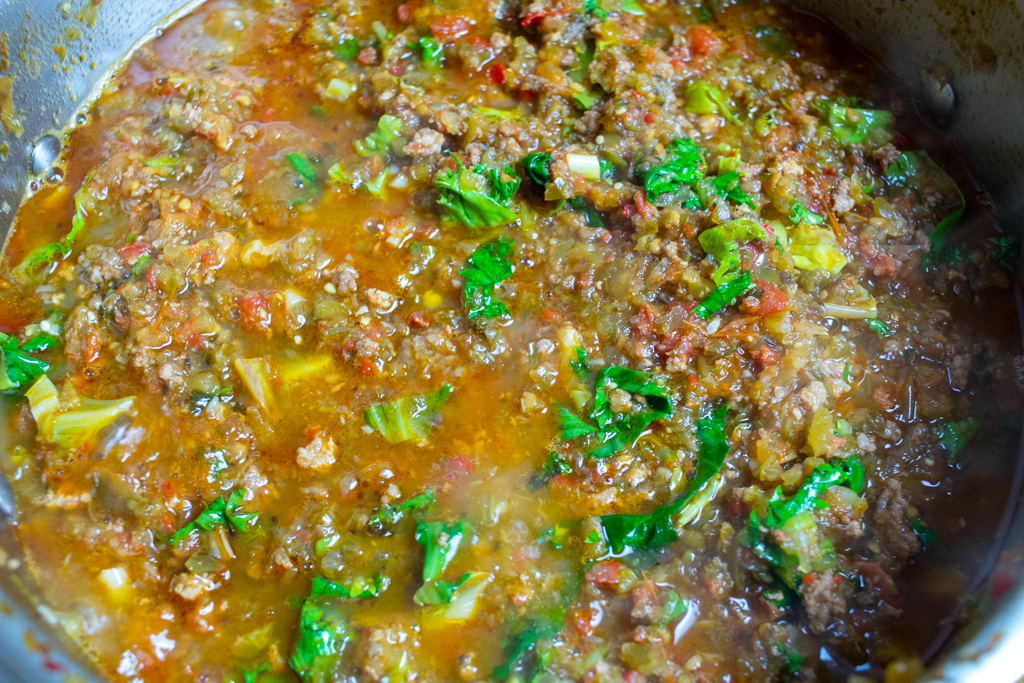
Carpenter says once the South American mixture has fully reduced, to season it with salt and pepper and serve it on sliced Italian bread. There is a recipe for Italian bread in her cookbook, but I chose Pane Turano instead. Pane Turano is a 2lb round loaf with a fairly chewy crumb that I felt would be a sturdy base for this meaty and saucy filling. I started by cutting a slice in half and buttering one half to help keep the sauce from soaking in.
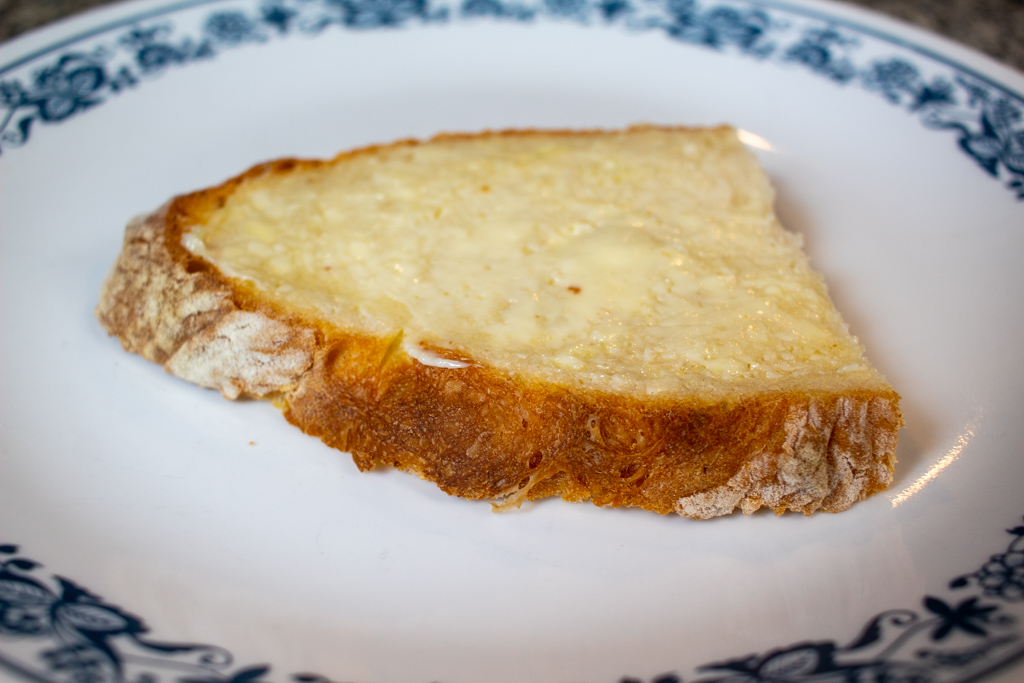
Then I ladled a generous amount of meatsauce over the bread.

and I finished the sandwich with the other half of my bread.

Despite the butter, my meatsauce inundated the bottom slice of bread, and the sandwich had to be inverted for my safety while consuming. The sauce was intensely savory–between the tomatoes and the mushrooms and the many meats and vegetables it had about every kind of umami-producing substance in abundance. I had underseasoned it somewhat, but what it lacked in salt it more than made up for in the mouthfilling sensation of savoriness that synergy provided.

It was also, sadly, almost entirely wrong.
A Sauce is not a Spread
Here’s the thing: ask anybody from the Iron Range how I’ve done and I’m pretty sure they’d tell you that I hadn’t made a South American; I’d made a Sloppy Joe. And anybody from the range will also tell you, often without you even asking: a South American is not a Sloppy Joe.
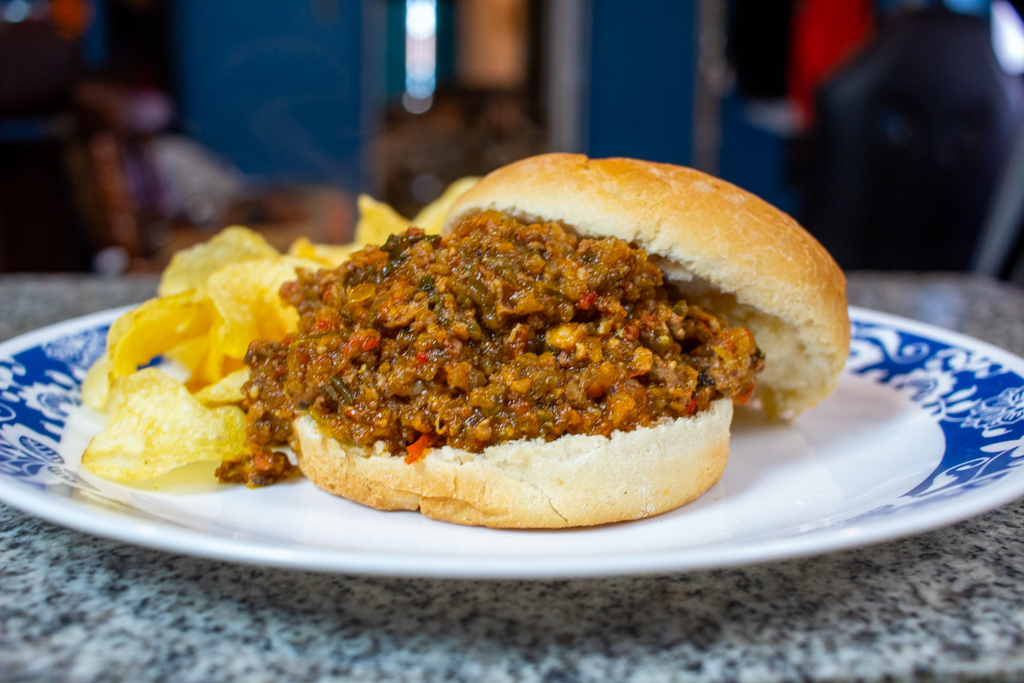
So yes, I made a Sloppy Joe from it, and it was exceedingly sloppy–the bottom half of this Kaiser roll essentially disintegrated when I tried to pick it up. Reading back, I started to see my mistake. The “back in the day” tales accompanying the recipes spoke of stretching the South Americans further by using thick slices of bread with relatively little of the meat. I had kept thinking of this as a sauce, something that despite containing many solids behaved mostly like a liquid. None of the recipes I had consulted in making my version of the South American described this mixture as a sauce, though. The ones that did categorize it in that way called it something different.
They called it a spread.
South American, Take 2
So I put the half-gallon or so of the South American “sauce” that I had left back into a pot and reduced it even further. I reduced it until little to no liquid remained, just small soft pieces of minced organic matter glued together by a residual film of fatty moisture. I had cooked all color out of it by this point so I chopped up a little fresh parsley and spread some onto Italian bread.
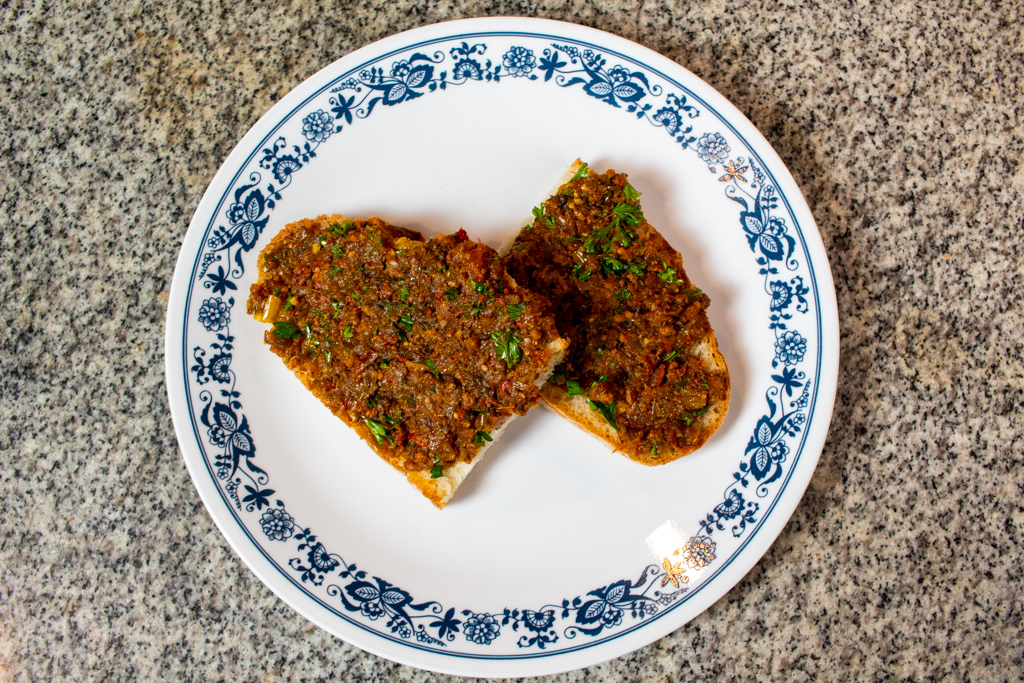
As we zoom in closer to the bread the differences become more apparent. This bread is in no danger of falling apart from moisture. There is no danger of mistaking this for a Sloppy Joe because there is no “sloppy” to it.
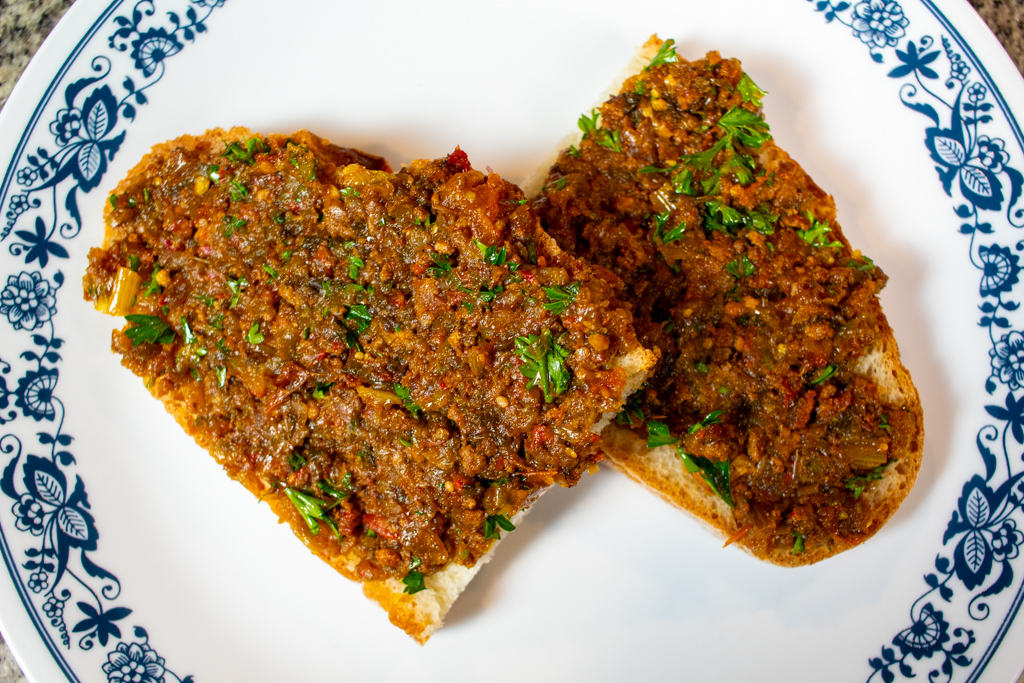
It is not dry–there is plenty of residual moisture in the bits of vegetable, of meat, in the medium that allows them to stick to eachother and to the bread. And since the already intensely-savory flavor has concentrated further, a little goes a long way. These slices of bread could have been much thicker without diluting the South American flavor.

Many of the recipes I read suggested serving it just like this, spread plainly onto sliced Italian bread or a baguette half, open-faced. There is flavor to spare here, though. Adding a second slice of bread doesn’t take anything away from this sandwich.
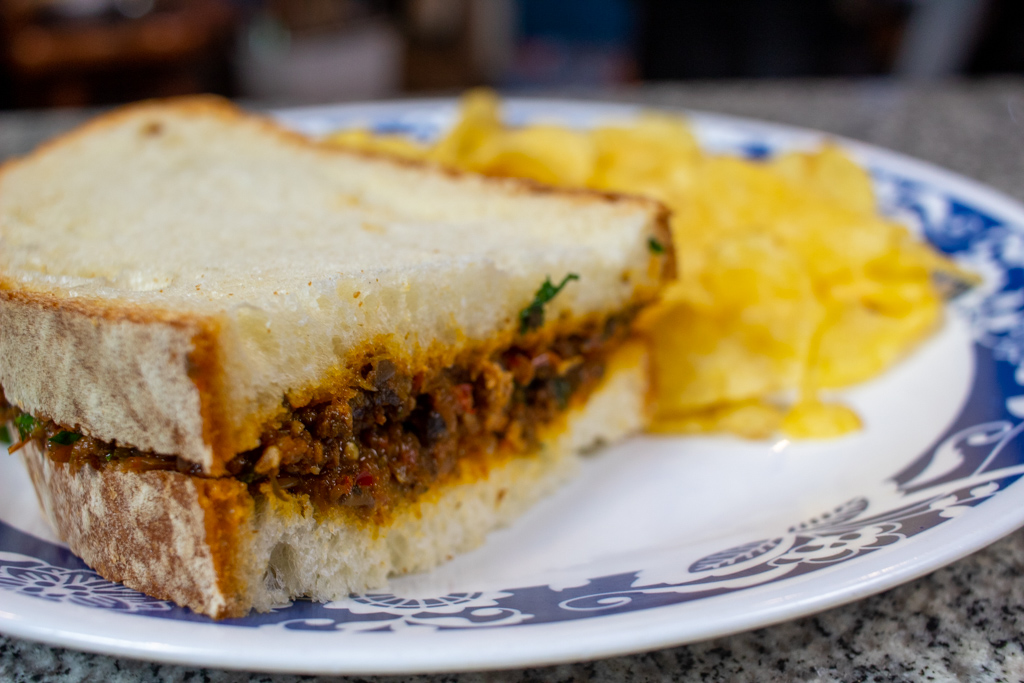
Could you add sliced onion, or mustard, or pickles or tomato or lettuce or any number of other standard American sandwich condiments? You could, sure. But you don’t need to, and that is I think part of the appeal. The South American is simple, self-contained, intense enough to provide the big flavors a more demanding palate might require, but approachable enough not to frighten off a fussier eater. It is not a Sloppy Joe–it’s more than that, better than that. But you know, a Sloppy Joe eater probably wouldn’t be terribly bothered by the differences.

I like sandwiches.
I like a lot of other things too but sandwiches are pretty great





















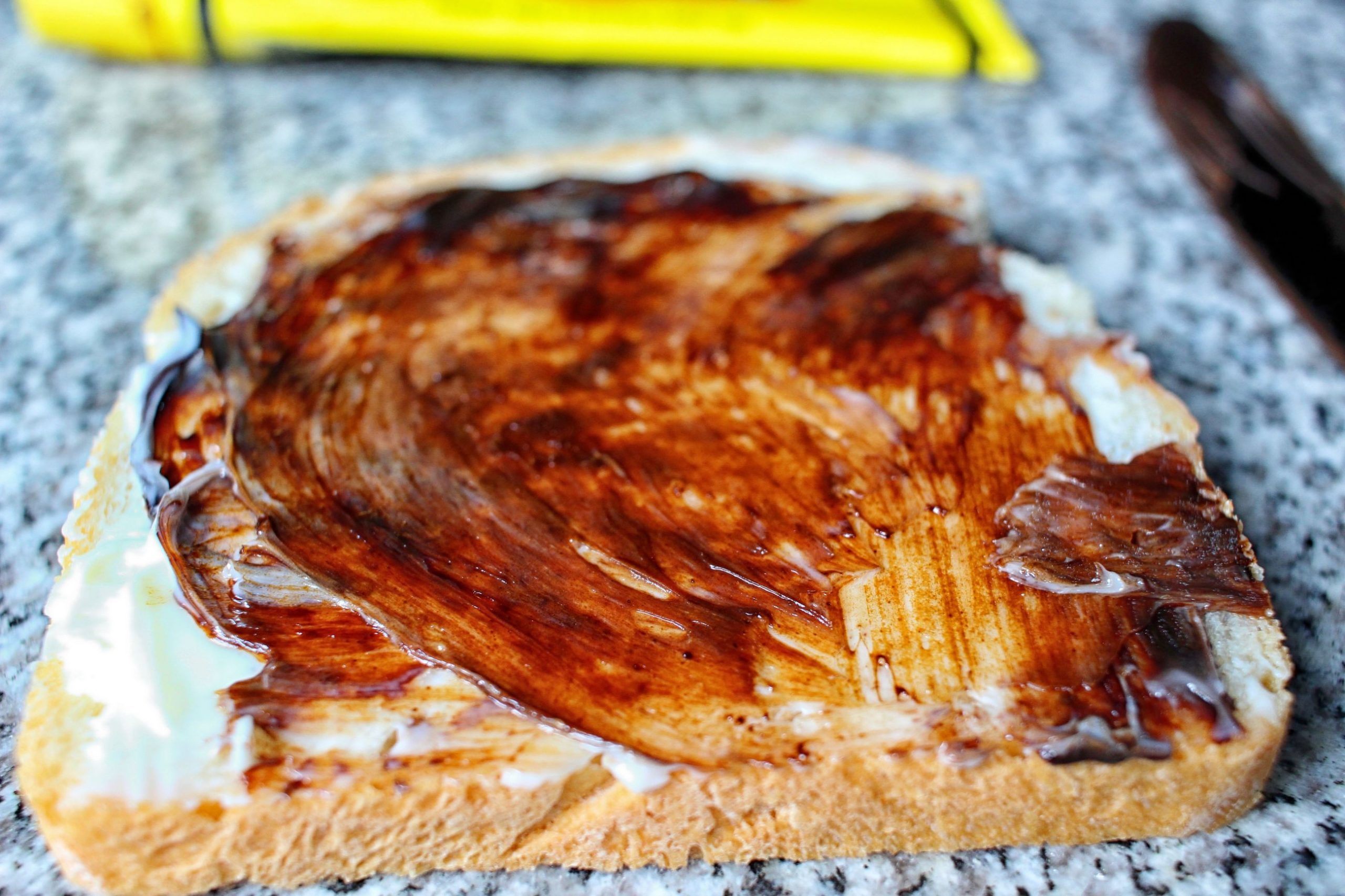







Recent Comments